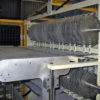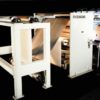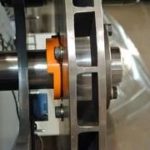Seal Products, based in Naugatuck CT, has been a quality supplier of laminated film and paper products since 1936.
Serving the sign and display industry, as well as framing shops and photo labs, the company’s product line is used with mounting and laminating presses, and in photographic framing.
Equipped with two shaft type roll stands, the Maxson MSE Sheeter handles a variety of Seal Products’ material from films as light as 2 mils thick to 0.012 inches thick.
During the past fifty years, Seal Products has enjoyed modest growth and has earned a reputation for both service and quality. In recent years, however, demand for the company’s products has risen sharply. As a result, the company’s size has doubled during the past five years.
In 1990, Seal Products was acquired by Hunt Manufacturing, of Philadelphia PA. As a subsidiary of Hunt, the company enlarged its distribution network outside of the United States, to include facilities in the United Kingdom and Germany. The expansion allowed Seal Products to better serve a growing worldwide customer base.
The company employs 120 workers at its Naugatuck CT manufacturing facility. Converting processes at the plant include sheeting, slitting and rewinding, as well as pouch making. The company converts a wide range of materials from adhesives, films, coated papers, and pressure sensitive stock.
While sheeting had been in practice since the company’s inception, it was one area that needed updating as demand for laminate sheets increased. According to Armand Luzi, operations manager, ” Despite having two sheeters, we reached a point where we had to have some material sheeted by an outside source. While we were growing as a company, there was no sheeting capacity to take on the additional work.”
As an option, the MSE Sheeter can be equipped with a slow down feature to allow for board insertion at counts of 25, 50, or 500 sheets.
He continues, ” New equipment offered greater speeds and the flexibility to do more. Faster changeovers and reducing set-up time were also an issue.”
After investigating several sheeter designs, Seal Products selected the MSE Sheeter from Maxson Automatic Machinery Company (Westerly RI). ” The MSE Sheeter was not very expensive, plus it was versatile and dependable. Jogging quality and delivery of the sheets into the stacker were in line with our requirements.”
The MSE Sheeter’s compact design requires only a single operator. At Seal Products, the unit handles materials with a variety of basis weights, from films as light as 2 mil up to 0.012 inches thick. The new sheeter runs consistently at 200 fpm, although on wider format sheets, speeds of up to 400 fpm have been realized.
Luzi remarks, ” On our older equipment, we only operated at about 80 fpm. The new sheeter has increased our capacity by almost 100 percent. The result is our stock is replenished faster and we are able to react more quickly. As a consequence, we’ve been able to improve our service levels.”
For Seal Product’s application, the MSE Sheeter was customized with a slow down feature to allow for board inserting at counts of 25, 100 or 500 sheets. He explains, ” In the past, our operators had to hand count the sheets and insert a board into the pile off-line. It was time consuming and inefficient.
The ability to slow down the sheeter at a specific count to insert a board means there is less handling. Now the task can be accomplished three times faster.”
In Luzi’s opinion the greatest single advantage of the new sheeter has been the capacity it has afforded. He remarks, ” We now have the flexibility to handle all our sheeting demands, without increasing our labor cost.”
The addition of a new sheeter has complemented Seal Product’s philosophy of service and quality, by making it easier to supply product to their customers. Plans for future growth include the introduction of a desktop laminating system for consumers, which will utilize the company’s film products. If the success of last five years are any indication, Seal Products appears to be headed on the right track.
Reprinted from The Sheeting Monitor, June 1995






